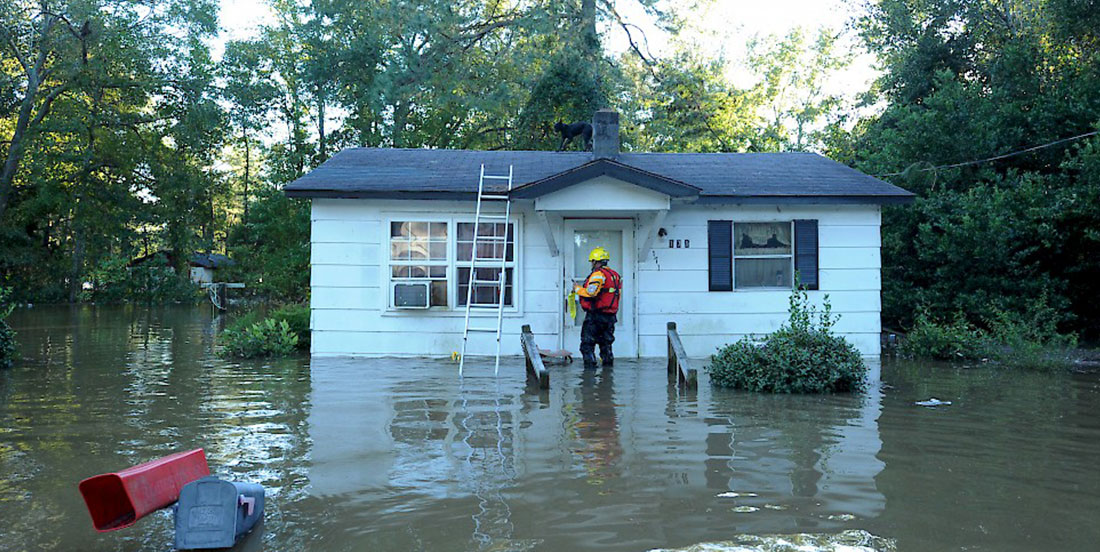As communities become more impacted by all types of disasters, society is constantly coming to new realizations. Solely relying on governmental agencies to perform emergency response and recovery tasks is insufficient. The frequency, scale, and impact of disasters make it more challenging to stage resources in the right place. Perhaps a more prepared citizenry would help the overall disaster response and recovery. Research of three leading institutions into how concerned the public is about preparedness and its effectiveness has begun to paint an informative picture for creating public outreach efforts.
The Johns Hopkins Preparedness and Emergency Response Research Center (JH-PERRC), the National Center for Disaster Preparedness (NCDP) at Columbia University, and the Natural Hazards Center (NHC) at University of Colorado each offer valuable research into how society views the issue of disaster preparedness. Each project is described below.
Johns Hopkins Public Preparedness Project #2
This research reviews disaster preparedness in the public health field. Hopkins researchers found that the overall public health construct becomes strained when disaster strikes. This overwhelming of the system is magnified when viewed through the prism of mental health. Disaster trauma has also been found to be paralyzing to a response effort.
Johns Hopkins Preparedness and Emergency Response Research Center (JH-PERRC) asserts that establishing a stronger relationship between faith-based organizations (FBO) and local health departments (LHDs) could strengthen the response to disaster trauma. JH-PERRC’s research project involved engaging both FBOs and LHDs in a two-phase approach to coordinated disaster mental health planning.
Established training focusing on proven preparedness practices was offered to educate the FBOs in the world of disaster preparedness. Another training aspect increased the understanding and recognition of how to work with persons who have been affected by disaster trauma. Mutual aid agreements long associated with municipal organizations were developed to work between FBOs and LHDs. Specific outcomes were beneficial to the three operational viewpoints expressed with this research (Hopkins Project 2).
FBOs:
- To have a cadre of trained members capable of providing mental health support to a community during times of need, either informally through parish outreach, or formally through participation in the Medical Professional Volunteer Corps; and
- To possess a complete emergency preparedness plan that will be shared with the JH-PERRC and may be shared with the LHD.
LHDs:
- To have formal and informal alliances with FBOs and communities within a jurisdiction; and
- To develop emergency preparedness plans with guidance based on knowledge of needs and requirements for successful public health emergency response.
JH-PERRC:
- To successfully facilitate workshops that lead to a strong and sustainable working relationship between the LHD and FBOs; and
- To provide evidence that a three-party relationship between an academic health center, LHD, and FBO is feasible for improving surge capacity and capability in public health emergency response.
As it relates to the goals and objectives of the research, the outcomes were found to be beneficial to the organizations targeted. The operational recommendations have begun to demonstrate improvements in the areas of disaster preparedness and readiness.
National Center for Disaster Preparedness
The research program at the National Center for Disaster Preparedness (NCDP) at Columbia University sought to review the attitudes and opinions of citizens regarding preparedness at all levels. The understanding and realization of what it means to be prepared were highlighted after the 9/11 attacks. According to NCDP’s findings, public opinion dropped sharply regarding beliefs that the government was able and prepared to protect the country. NCDP researchers began in 2003 to periodically review public opinions to better understand how the preparedness message is being received and woven into their minds and lifestyles. They chose surveys as their methodology and deployed them across varying age groups of the citizenry in hopes to gain the strongest representation. Their 2015 research demonstrates the most recent opportunity to review the effects that the overall discussion of disaster preparedness has had on public opinion since 9/11.
According to the NCDP’s 2016 report, “American Preparedness Project: Where the US Public Stands in 2015,” “In 2015, 50% of people state that their family has a family emergency preparedness plan, a steady increase from 35% in 2003.” Although this is encouraging, it is still not as high a percentage as it should be in the public arena. Considering the 2017 devastation in Puerto Rico caused by Hurricane Maria, public opinion about the government’s ability to effectively respond to natural disasters has become increasingly negative. However, this is not new. This was also the view of the public for years after the government’s somewhat slow and ineffectual response to Hurricane Katrina in 2005 (NCDP, 2016):
Ten years after Hurricane Katrina, over a quarter of the population (25.6%) does not think the country is any better prepared to deal with a major natural disaster than it was before Hurricane Katrina. Compared with 2008, when the question was first asked, this is an increase of 7.5% in the population that believes the country is better.
Research has shown that, with the increased awareness regarding preparedness, there is still a fundamental disconnect with the messaging reaching, and becoming actionable, by the public. The NCDP report identified specific recommendations to help preparedness concepts reach more of the public arena, such as:
- Individuals and households should invest more in their disaster preparedness planning.
- Government agencies should cooperate with trusted community leaders and organizations to ensure better community and individual engagement in disaster planning.
- The impact of climate change on disasters should be better understood and integrated into communications and preparedness programs.
- Preparedness programs could benefit from taking into consideration the disparities in responses from different geographic, socioeconomic, and other strata of the presented data.
- First responders should work with their communities to ensure they are prepared to meet the community’s response expectations in a disaster.
Natural Hazards Center
The Natural Hazards Center (NHC) at the University of Colorado, along with The Fritz Institute, assessed with their 2006 research disaster preparedness of the civilian population within three viewpoints: households, businesses, and community organizations. The purpose was to recognize and evaluate the differences and commonalities of preparedness levels found between the viewpoints.
The NHC utilized a survey to gather information for the project. The following set of metrics within the survey was found to be common and useful across all areas:
- Hazard knowledge;
- Formal and informal response plans and agreements;
- Life safety protection;
- Property protection;
- Initiation of recovery;
- Ability for emergency coping and restoration of key functions;
- Supportive resources; and
- Management, direction, and coordination.
Household surveys revealed many deficiencies within the household preparedness construct. For example, many did not have a strong understanding of the types of hazards within their living areas. Recommended ways to improve on this were to encourage households to communicate with local municipal officials, as well as to inquire about the common hazards and emergency plans of the city. This information should be added to the household disaster preparedness plan.
In addition, the analysis described in the 2006 report shows that businesses have stepped up their preparedness considerations:
A scan of the business continuity literature over the past five years shows that there has been an increase in the number of practitioner-focused publications on business preparedness as well as a shift in focus from information security and recovery to business continuity and prevention.
One area where businesses were identified as showing themselves to be somewhat lacking was in the management, direction, and coordination area due to having underdeveloped preparedness programs. The report further states the following:
The CDC suggests that a pandemic coordinator and/or team as well as essential employees must be identified to develop a disaster plan and get prepared for pandemic influenza. Across all hazards, businesses are directed to develop disaster response plans for life safety, property protection, and business continuity and to instruct employees to develop household plans to ensure resumption of operations as quickly as possible post-disaster.
The goal is to improve readiness by having the appropriate personnel and training developed to respond efficiently and having essential functions and services restored as soon as possible.
Similar results were seen with the community organization’s survey information. It is noted that the development of a disaster preparedness plan for the community helps to localize and make more effective the response efforts, which are critically time sensitive.
Other Programs & Community Efforts
Overall, the public perception of disaster preparedness has been increasing, as well as the action that accompanies that understanding. Programs such as the Community Emergency Response Team (CERT) educate and train community volunteers on emergency preparedness. CERT volunteers learn useful skills in neighborhood disaster response as well as light search and rescue activities. The Medical Response Team (MRT) is another program that enhances the emergency medical resources of a community. Volunteer based, it offers participants who are trained in various medical professions to form response teams during a disaster. These teams act as a resource multiplier when systems become overwhelmed. Participation in these programs has increased over recent years as these programs are being developed in communities across the country.
However, this new appreciation for preparedness has not grown to a high enough level across all aspects of the population. Many people still believe that it is the government’s role to provide disaster response services.
Although businesses have improved their preparedness thinking – due to continuity of operations plans (COOP) becoming increasingly adapted into corporate plans – there are still gaps in recognizing the need for disaster preparedness training for all levels of personnel and establishing qualitative employee disaster preparedness programs.
Although community organizations are sometimes underserved, they do have great potential for improvement. With all disasters being local, having the ability (through training and education) to respond immediately to a disaster leads to saved lives, saved property, and a protected environment. Strong disaster preparedness practices are necessary for significantly reducing recovery time, thus allowing for a quicker return to “normal.”

Jeffrey Odoms
Jeffrey Odoms, M.A., is currently the president at EMPREP Consulting. He has over 24 years of experience in the field of environmental emergency response and compliance. During his career, he has deployed to various emergency management assignments and recovery efforts, specifically for the 2004 and 2005 Hurricanes Frances, Jeanne, Wilma, and Katrina. He was awarded the State of Florida Distinguished Service Medal for his disaster response efforts Hurricane Irene of 1999. He holds a B.S. degree in Project Management and a M.A. degree in Emergency/Disaster Management. He is also credentialed in the state of Florida as a FEMA Incident Command Course and National Incident Management System Instructor.
- This author does not have any more posts.






